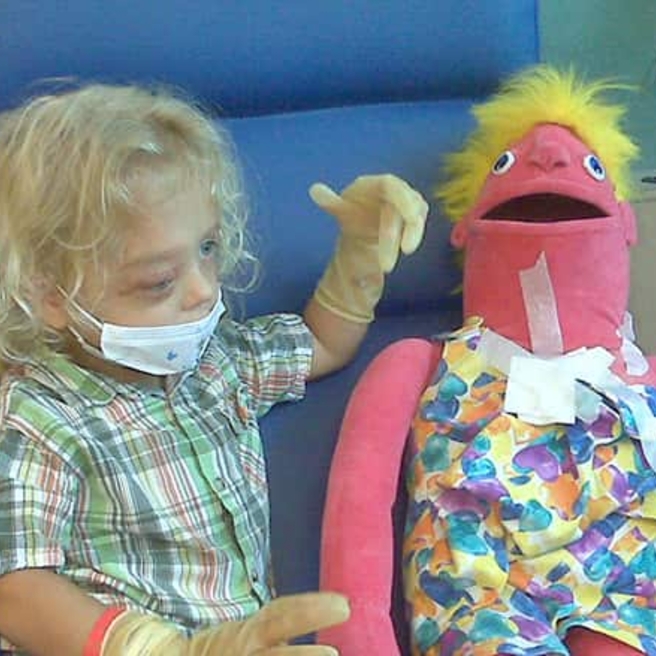What is neurofibromatosis type 1?
Neurofibromatosis type 1 (NF1) is a genetic disorder that can affect multiple systems of the body. It is characterized by the presence of:
- Skin changes, such as café-au-lait spots (light brown patches on the skin), and freckles in the armpits or groin area
- Iris Lisch nodules (benign growths on the colored part of the eye)
- Skeletal abnormalities, including scoliosis and bowing of the legs
- Large head size
- Learning disabilities
Affected individuals are also at increased risk of developing certain benign tumors of the nervous system, especially:
- Neurofibromas (benign tumors of the nerves that form on or under the skin)
- Optic pathway gliomas (tumors that form along the optic pathway, which connects the eye to the brain) and other low grade gliomas
Other tumors and forms of cancer that occur more frequently in patients with NF1 include:
- Malignant peripheral nerve sheath tumors (a malignant tumor of the nerves)
- Pheochromocytomas (tumors of the adrenal glands, the small hormone producing organs located on top of each kidney)
- Leukemia, especially juvenile myelomonocytic leukemia (a blood cancer that affects young children)
- Breast cancer
- Gastrointestinal stromal tumors (tumors that form along the gastrointestinal tract)
- Rhabdomyosarcoma (tumors of the muscles)
Other complications seen in patients with NF1 include:
- Learning and/or attention problems (which occur in about half of individuals with NF1 and persist into adulthood)
- Scoliosis
- High blood pressure
- Seizures
- Stroke and changes in the blood vessels in brain
Children with NF1 may also have personality and/or behavioral differences compared to children who do not have NF1.
The incidence of NF1 is approximately one in 3,000 live births and it affects males and females of all races equally.
Because neurofibromatosis type 1 is hereditary, the risk of developing the features associated with NF1 may be passed from generation to generation in a family. However, the type and severity of this disorder can vary widely between affected family members.
Causes
Neurofibromatosis type 1 is caused by alterations (mutations) at specific areas within a person's genetic information. Each of us has a large amount of genetic information that is organized into smaller segments known as “genes.” Genes provide the necessary instructions that our cells require to perform their different functions within our bodies.
In the vast majority of patients with neurofibromatosis type 1, the disorder develops as the result of alterations in a specific gene known as nf1, which is located on chromosome 17. nf1 is the only gene known to be associated with neurofibromatosis type 1. The nf1 gene produces a protein that acts as a “tumor suppressor,” which means it helps keep cells from growing and dividing too quickly.
Every cell of the body (except the egg and sperm cells) normally has two working copies of the nf1 gene, one from each parent. People with neurofibromatosis type 1 generally carry an alteration in one copy of the nf1 gene. Over time, the second working copy of the nf1 gene may become altered within one or more cells. The loss of function of the second nf1 gene copy leads to abnormal growth and division of the affected cells, increasing their chance of developing tumors.
How is neurofibromatosis type 1 inherited?
Approximately 50 percent of people with neurofibromatosis type 1 inherited an altered copy of the nf1 gene from a parent who also has neurofibromatosis type 1. In the remaining 50 percent of people, neurofibromatosis type 1 resulted from the development of a “new” mutation in the nf1 gene in the father’s sperm, mother’s eggs, or in a cell of the developing fetus. In these scenarios, affected individuals will be the first one in their family to carry this genetic change.
People who carry an alteration in one copy of the nf1 gene in all the cells of their body have a 50 percent (or 1 in 2) chance of passing this same alteration on to each of their children. Children who inherit the altered gene copy will have neurofibromatosis type 1 and will therefore be at risk of developing the features associated with this disorder.
Testing and diagnosis
A clinical diagnosis of neurofibromatosis type 1 (NF1) is made when a person has two or more of the following features:
- Six or more café-au-lait spots measuring at least :
- 5 millimeters in greatest diameter in prepubertal individuals
- 15 millimeters in greatest diameter in postpubertal individuals
- Two or more neurofibromas or one plexiform neurofibroma (a thick, irregular neurofibroma that usually involves multiple nerves)
- Freckles on the armpits or groin
- An optic pathway glioma
- Two or more iris Lisch nodules
- Specific bony changes, such as sphenoid wing dysplasia (abnormality in a skull bone) or thinning of the long bones of the tibia (lower leg bone)
- A first-degree relative with a diagnosis of neurofibromatosis type 1
A detailed review of an individual’s medical and family history is important in diagnosing NF1. A doctor or genetic counselor may gather information that indicates which members of the family have developed clinical manifestations of neurofibromatosis type 1 (NF1), such as café-au-lait spots or neurofibromas. If the pattern of clinical features and/or cancers is suggestive of neurofibromatosis type 1 , the physician or counselor may recommend genetic testing.
Genetic testing
In order to confirm on a molecular level that an individual has neurofibromatosis type 1 (NF1), he or she can undergo genetic testing:
- Generally, a sample of blood is obtained.
- DNA is isolated from this sample, and the two copies of the nf1 gene are analyzed using a variety of methods and compared to the normal reference sequence for the nf1 gene.
- If an alteration in one nf1 gene copy is identified, the genetic counselor can examine whether the alteration has been previously reported in other individuals with NF1.
It is estimated that approximately 90 to 95 percent of individuals carrying a clinical diagnosis of NF1 will have a mutation involving the nf1 gene. Some individuals may be "mosaic" and not have a detectable alteration of nf1 in their blood cells. Therefore, the failure to identify an alteration in the nf1 gene does not always exclude the clinical diagnosis of neurofibromatosis type 1 (NF1).
A person who is mosaic for NF1 has two populations of cells that make up the body. One contains two working copies of the nf1 gene (these cells are normal) and the second population contains one working copy and one non-working copy of the nf1 gene (these cells are abnormal). Individuals with NF1 mosaicism may show signs of the disease only in parts of the body that contain abnormal cells.
Because it is difficult to know which cells of the body of a person with NF1 mosaicism are affected, it is not possible to predict the exact risk to develop tumors or other complications of NF1 or to pass the altered gene copy on to future children.
Neurofibromatosis type 1 (NF1) genetic test results can also provide important information for other family members. If a mutation responsible for neurofibromatosis type 1 (NF1) syndrome is identified, at-risk relatives (first or second degree relatives) can be tested for the same genetic alteration.
Tumor risks
Almost all individuals with neurofibromatosis type 1 eventually develop neurofibromas, benign (non-cancerous) tumors that form along nerves on the skin, or elsewhere in the body. The tumors may be removed for cosmetic or medical reasons if needed.
In some cases, however, the internal tumors and those called “plexiform neurofibromas” may undergo malignant changes and behave like cancers. Up to 10 percent of individuals with NF1 may develop cancerous neurofibromas, called malignant peripheral nerve sheath tumors.
Brain tumors are the second most common tumor that occurs in individuals with neurofibromatosis type 1. Most of the brain tumors that occur in neurofibromatosis type 1 are low-grade astrocytomas. They can occur anywhere in the brain, but most often occur along the optic pathway, and therefore can affect vision. Most of these tumors occur by 6 years of age. Fortunately, most of these tumors do not grow significantly and do not affect vision.
Although cancerous neurofibromas and central nervous system tumors are the most common malignancies in NF1, affected women may also face a moderately increased risk of breast cancer development.
If your child has already been diagnosed with NF1 and you notice that a growing tumor is beginning to cause a problem, tell your doctor immediately.
Learning problems and neurofibromatosis type 1
Approximately half of individuals with NF1 have some learning issue, which can affect school function. Although severe IQ drop is rare, many children with NF1 have impairments in attention, working memory, visuospatial function, and/or fine motor skills. Children with developmental delays or who are struggling in should be formally evaluated for learning issues.
If your child has a learning disability one of the most important things to do is to have formal neuropsychological testing and to get early intervention. A social worker can help you work with your child’s school. If your child isn’t in school yet you can work with early intervention to help your child get started on the right foot.
Recommended screening protocols
Although most of the tumors associated with neurofibromatosis type 1 are benign, individuals with NF1 should be monitored for the development of these tumors. Some can cause complications, such as loss of vision with optic pathway gliomas. It’s also important to carefully monitor neurofibromas for signs that might indicate malignant transformation.
The recommended cancer screening protocol for patients with NF1 includes:
- Annual physical evaluations (including blood pressure monitoring) by a physician familiar with the patient and the disorder
- Annual ophthalmologic screenings in early childhood, less frequent examination in older children and adults
- Other evaluations depending on symptoms
Other recommended screenings include:
- Regular assessments of developmental and school progress in children
- Monitoring of those who have abnormalities of the central nervous system, skeletal system, or cardiovascular system by an appropriate specialist
- Investigation of clinically apparent signs and symptoms through further studies
Reproductive options
A person with neurofibromatosis type 1 (NF1) who does not wish to pass this disorder on to future children has several reproductive options, including:
- Prenatal diagnosis: DNA is obtained from the cells of the embryo through chorionic villus sampling (CVS) or amniocentesis. The DNA is analyzed for alterations in the nf1 gene.
- Preimplantation Genetic Diagnosis (PGD): For couples using in vitro fertilization to become pregnant, embryos can be tested for genetic disorders before transferring them into the uterus. Only healthy embryos carrying two working copies of the nf1 gene would be implanted.
Before one can proceed with prenatal testing or PGD, an NF1 mutation must be identified in a parent with neurofibromatosis type 1. Using either method, a parent can work with a genetic counselor and/or physician to decide whether to carry the pregnancy to term or to end the pregnancy.
Before one can proceed with prenatal testing or PGD, an nf1 gene mutation must be identified in a parent with neurofibromatosis type 1. Using either method, a parent can work with a genetic counselor and/or physician to decide whether to carry the pregnancy to term or to end the pregnancy.
Resources to help
Neurofibromatosis type 1 Resources
Neurofibromatosis Program Resources
We have gathered resources to give you information and help you find answers to your questions. We hope this helps your family deal with any challenges you face.
Reviewed by Kristin Zelley, MS, LCGC

